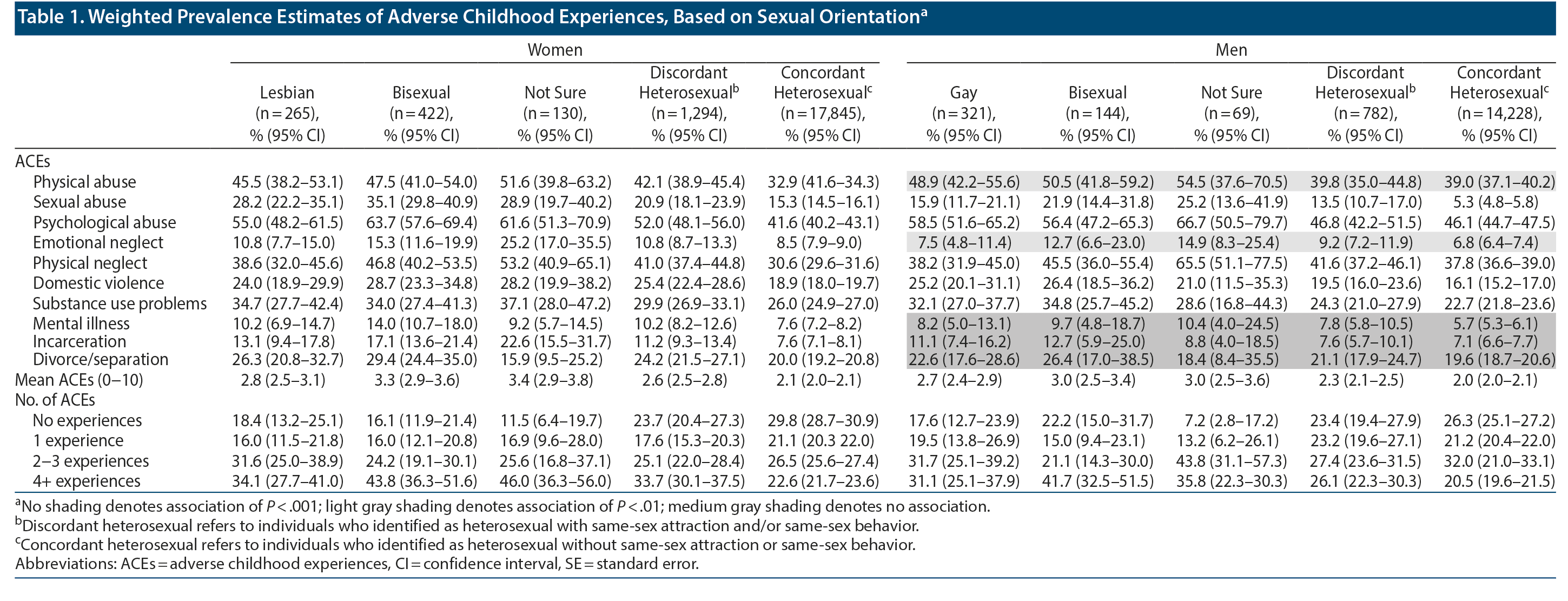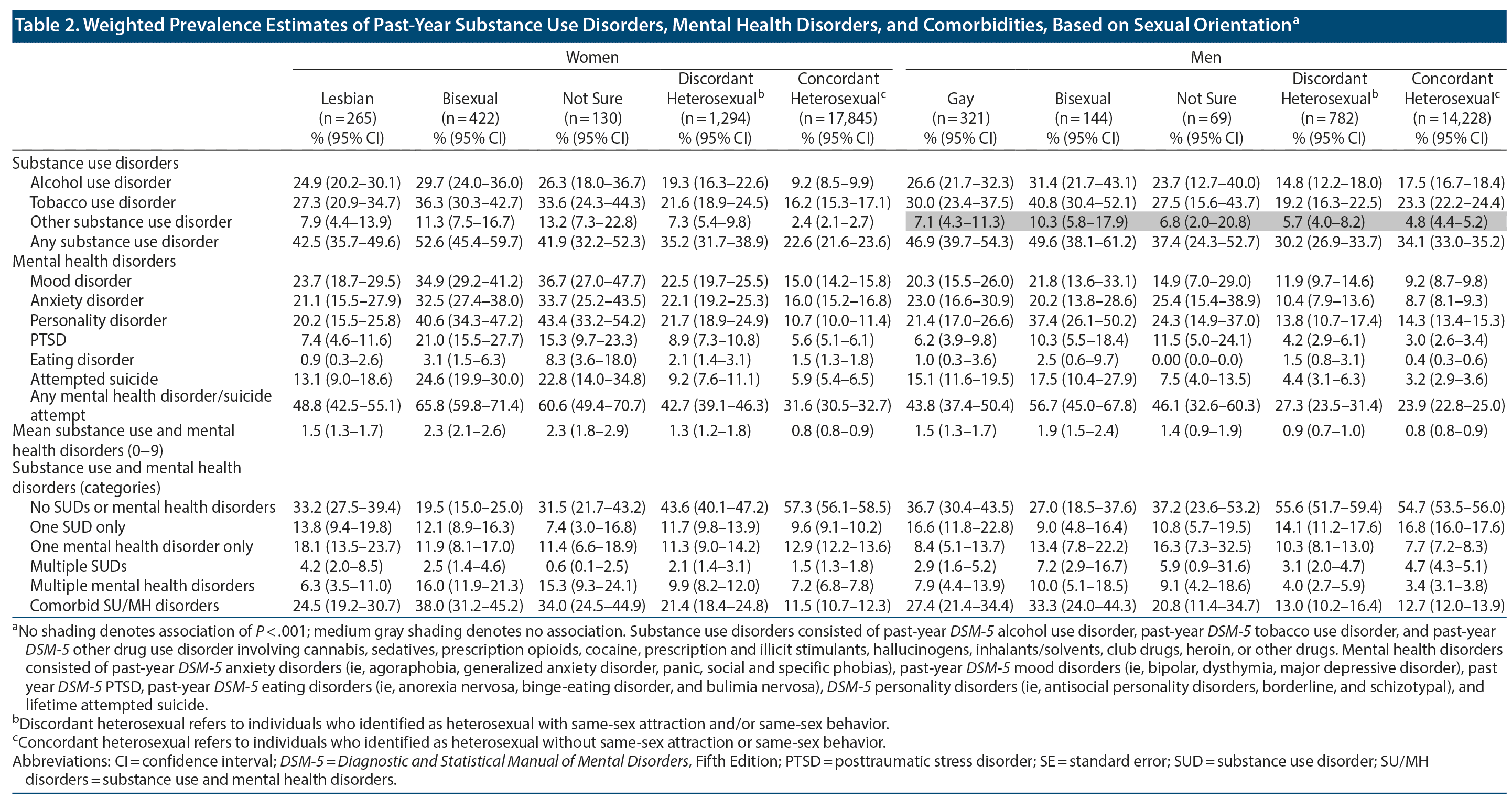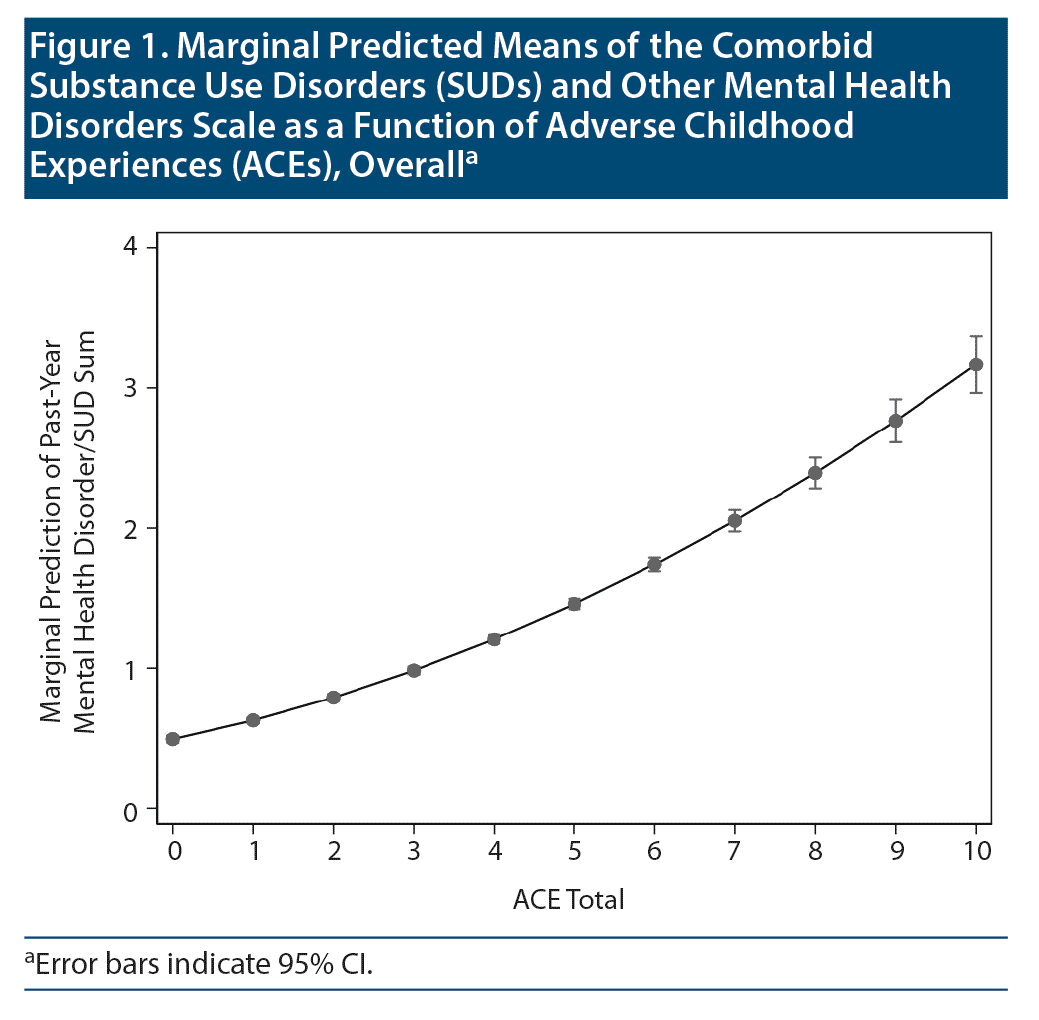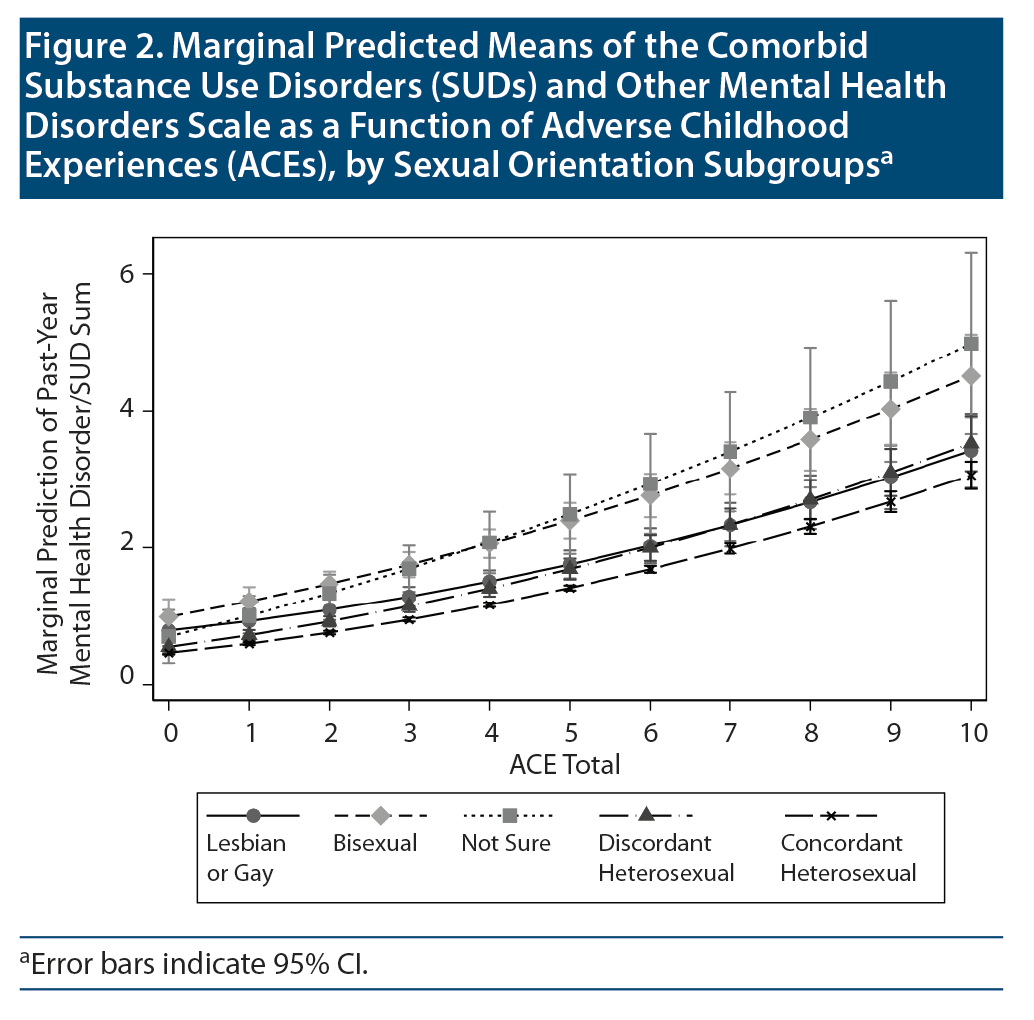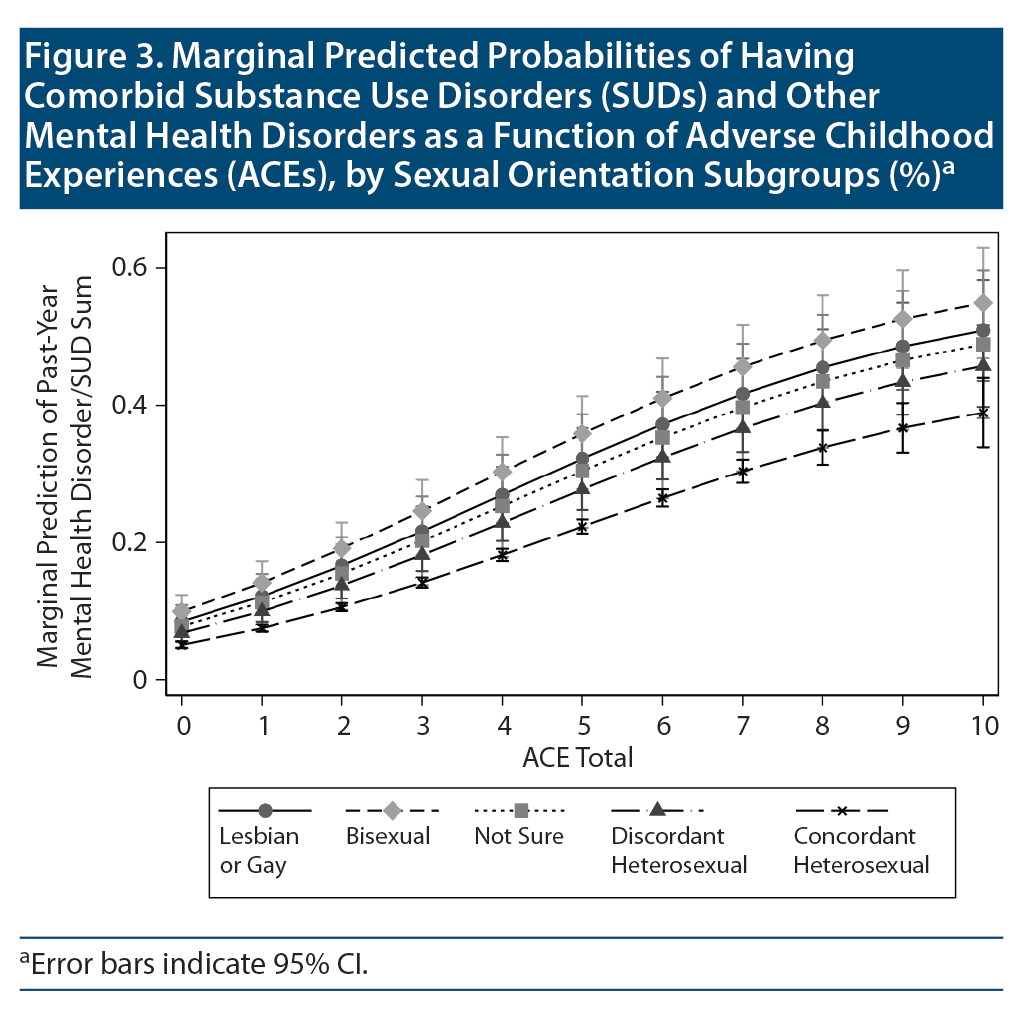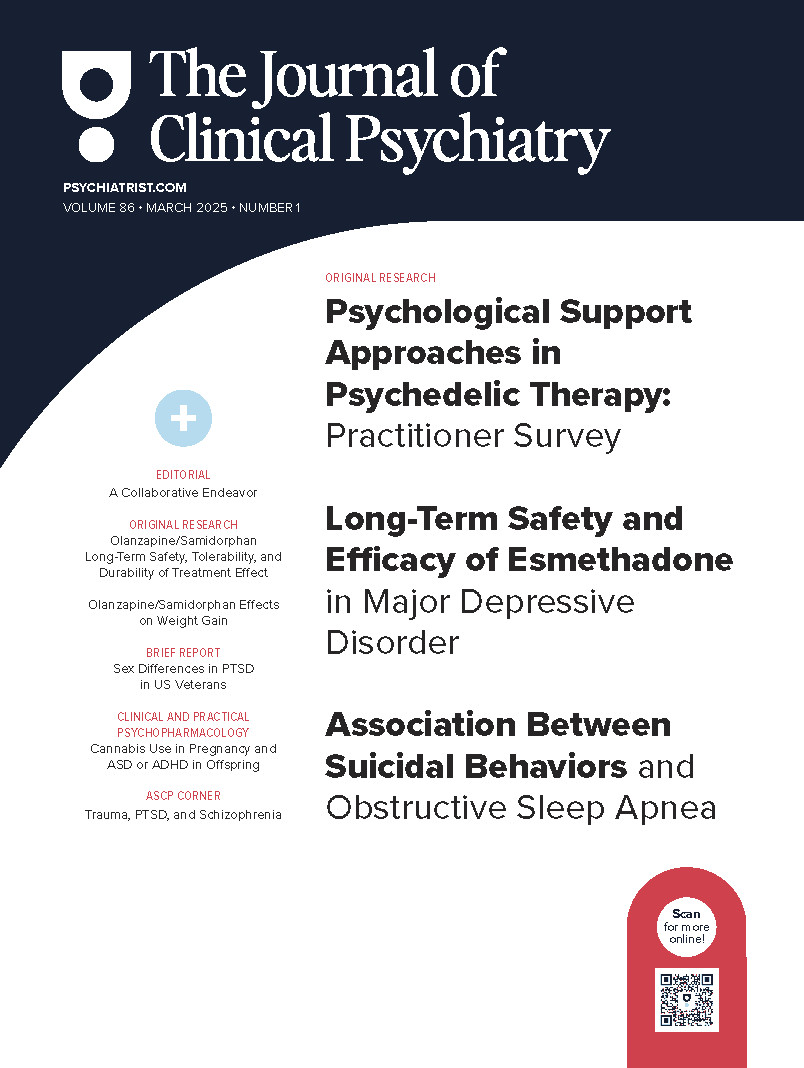Article Abstract
Objective: To assess the relationships between adverse childhood experiences (ACEs) and comorbid Diagnostic and Statistical Manual of Mental Disorders, Fifth Edition (DSM-5) substance use and mental health disorders across 5 sexual orientation subgroups: lesbian/gay, bisexual, unsure, discordant heterosexual (ie, heterosexual-identified with same-sex attraction or behavior), and concordant heterosexual.
Methods: Data were from the 2012−2013 National Epidemiologic Survey on Alcohol and Related Conditions-III, a cross-sectional, nationally representative survey of non-institutionalized US adults. Data were collected in households via structured diagnostic face-to-face interviews; the overall response rate was 60.1%. The sample included 36,309 US adults aged 18 years and older.
Results: Sexual minorities (gay, lesbian, bisexual), especially bisexual women, reported the highest prevalence of ACEs and comorbid substance use and mental health disorders. Approximately 43.8% of bisexual women reported 4 or more ACEs, and 38.0% of bisexual women reported comorbid substance use and mental health disorders. Multivariable regression analyses indicated a curvilinear relationship between ACEs and comorbid substance use and mental health disorders, and sexual minorities consistently had a higher ACE mean than concordant heterosexual respondents. The majority of sexual minorities with high levels of ACEs had comorbid substance use and mental health disorders.
Conclusions: Sexual minorities are exposed to more ACEs than their heterosexual counterparts in the US. We found evidence that US sexual minorities are at higher risk of comorbid substance use and mental health disorders. These findings reinforce the importance of identifying exposure to ACEs and developing trauma-informed interventions to treat comorbidities in those exposed to multiple ACEs, especially sexual minorities.’ ‹
Find more articles on this and other psychiatry and CNS topics:
The Journal of Clinical Psychiatry
The Primary Care Companion for CNS Disorders
CME Background
Articles are selected for credit designation based on an assessment of the educational needs of CME participants, with the purpose of providing readers with a curriculum of CME articles on a variety of topics throughout each volume. Activities are planned using a process that links identified needs with desired results.
To obtain credit, read the article, correctly answer the questions in the Posttest, and complete the Evaluation. This activity is free.
CME Objective
After studying this article, you should be able to:
- Screen patients with mental or substance use disorders for sexual minority status and adverse childhood experiences so that interventions can be tailored appropriately
Accreditation Statement
The CME Institute of Physicians Postgraduate Press, Inc., is accredited by the Accreditation Council for Continuing Medical Education to provide continuing medical education for physicians.
Credit Designation
The CME Institute of Physicians Postgraduate Press, Inc., designates this journal-based CME activity for a maximum of 1 AMA PRA Category 1 Creditâ„¢. Physicians should claim only the credit commensurate with the extent of their participation in the activity.
Note: The American Academy of Physician Assistants (AAPA) accepts certificates of participation for educational activities certified for AMA PRA Category 1 Creditâ„¢ from organizations accredited by ACCME or a recognized state medical society. Physician assistants may receive a maximum of 1 hour of Category I credit for completing this program.
Release, Expiration, and Review Dates
This educational activity was published in December 2020 and is eligible for AMA PRA Category 1 Creditâ„¢ through December 31, 2022. The latest review of this material was November 2020.
Financial Disclosure
All individuals in a position to influence the content of this activity were asked to complete a statement regarding all relevant personal financial relationships between themselves or their spouse/partner and any commercial interest. The CME Institute has resolved any conflicts of interest that were identified. In the past year, Marlene P. Freeman, MD, Editor in Chief, has received research funding from JayMac and Sage; has been a member of the advisory boards for Otsuka, Alkermes, and Sunovion; has been a member of the Independent Data Safety and Monitoring Committee for Janssen; has been a member of the Steering Committee for Educational Activities for Medscape; and, as a Massachusetts General Hospital (MGH) employee, works with the MGH National Pregnancy Registry, which is sponsored by Teva, Alkermes, Otsuka, Actavis, and Sunovion, and works with the MGH Clinical Trials Network and Institute, which receives research funding from multiple pharmaceutical companies and the National Institute of Mental Health. No member of the CME Institute staff reported any relevant personal financial relationships. Faculty financial disclosure appears at the end of the article.
ABSTRACT
Objective: To assess the relationships between adverse childhood experiences (ACEs) and comorbid Diagnostic and Statistical Manual of Mental Disorders, Fifth Edition (DSM-5) substance use and mental health disorders across 5 sexual orientation subgroups: lesbian/gay, bisexual, unsure, discordant heterosexual (ie, heterosexual-identified with same-sex attraction or behavior), and concordant heterosexual.
Methods: Data were from the 2012−2013 National Epidemiologic Survey on Alcohol and Related Conditions-III, a cross-sectional, nationally representative survey of non-institutionalized US adults. Data were collected in households via structured diagnostic face-to-face interviews; the overall response rate was 60.1%. The sample included 36,309 US adults aged 18 years and older.
Results: Sexual minorities (gay, lesbian, bisexual), especially bisexual women, reported the highest prevalence of ACEs and comorbid substance use and mental health disorders. Approximately 43.8% of bisexual women reported 4 or more ACEs, and 38.0% of bisexual women reported comorbid substance use and mental health disorders. Multivariable regression analyses indicated a curvilinear relationship between ACEs and comorbid substance use and mental health disorders, and sexual minorities consistently had a higher ACE mean than concordant heterosexual respondents. The majority of sexual minorities with high levels of ACEs had comorbid substance use and mental health disorders.
Conclusions: Sexual minorities are exposed to more ACEs than their heterosexual counterparts in the US. We found evidence that US sexual minorities are at higher risk of comorbid substance use and mental health disorders. These findings reinforce the importance of identifying exposure to ACEs and developing trauma-informed interventions to treat comorbidities in those exposed to multiple ACEs, especially sexual minorities.
J Clin Psychiatry 2020;81(6):20m13291
To cite: McCabe SE, Hughes TL, West BT, et al. Sexual orientation, adverse childhood experiences, and comorbid DSM-5 substance use and mental health disorders. J Clin Psychiatry. 2020;81(6):20m13291.
To share: https://doi.org/10.4088/JCP.20m13291
© Copyright 2020 Physicians Postgraduate Press, Inc.
aCenter for the Study of Drugs, Alcohol, Smoking and Health, Department of Health Behavior and Biological Sciences, University of Michigan School of Nursing, Ann Arbor, Michigan
bSurvey Research Center, Institute for Social Research, University of Michigan, Ann Arbor, Michigan
cInstitute for Research on Women and Gender, University of Michigan, Ann Arbor, Michigan
dCenter for Sexuality and Health Disparities, Department of Systems, Population and Leadership, University of Michigan School of Nursing, Ann Arbor, Michigan
eInstitute for Healthcare Policy and Innovation, University of Michigan, Ann Arbor, Michigan
fSchool of Nursing and Department of Psychiatry, Columbia University, New York, New York
gDepartment of Psychiatry, University of Michigan, Ann Arbor, Michigan
hDepartment of Surgery, University of Michigan, Ann Arbor, Michigan
*Corresponding author: Sean Esteban McCabe, PhD, Center for the Study of Drugs, Alcohol, Smoking and Health, University of Michigan School of Nursing, 400 North Ingalls St, Ann Arbor, MI 48109 ([email protected]).
There is evidence that adverse childhood experiences (ACEs) are more prevalent among sexual minorities than heterosexual individuals.1-6 For example, sexual minority women reported higher rates of childhood sexual abuse than heterosexual women.2 Furthermore, the prevalence of different types of abuse and victimization varies within the sexual minority population. In a national study, gay and lesbian adults were more likely to experience childhood physical abuse, while bisexual adults had a higher likelihood of experiencing intimate partner violence and housing adversity.4 The presence of ACEs can lead to stress and epigenetic changes that may contribute to the development of substance use disorders (SUDs) and mental health disorders.2,7-10
There is evidence that sexual minority adults with ACE exposure have a higher prevalence of substance use and mental health disorders relative to heterosexual adults.2,4,11-15 For instance, sexual minorities who report childhood adversity had a higher risk of subsequent alcohol use, tobacco use, suicidality, and depressive symptoms relative to heterosexual individuals.4 Additionally, psychological abuse by parents is more common among sexual minorities than heterosexual individuals.1 This excess childhood stress may lead to increased anxiety and depression in adulthood.
To date, SUDs and mental health disorders have been examined primarily as individual disorders rather than considered together as comorbid substance use and mental health (SU/MH) disorders (ie, the co-occurrence of at least 1 SUD and at least 1 mental health disorder). It is estimated that approximately half of people who have an SUD will experience a mental health disorder at some point in their lives, and vice versa.16,17 Comorbid SU/MH disorders create challenges in health assessments and treatment.18 Understanding the associations between ACEs and comorbid SU/MH disorders may ease these difficulties for clinicians treating sexual minority patients by creating a new path of detection and treatment. For example, if ACEs are more prevalent among sexual minorities with comorbid SU/MH disorders, clinicians who are aware of their patient’s ACE exposure could evaluate for SUD and mental health disorder symptoms and guide them to trauma-informed treatment plans.
Despite evidence indicating increased risk for ACEs, stress, substance use, and mental health disorders among sexual minorities, few studies have examined the relationship between ACEs and comorbid SU/MH disorders in a nationally representative sample of US sexual minority adults. To help fill this gap, the present study aimed to (1) estimate the prevalence of ACEs (eg, physical abuse, emotional neglect, sexual abuse) and comorbid SU/MH disorders (eg, alcohol use disorder and mood disorder) based on sexual orientation among US adults and (2) examine and compare the relationships between ACEs and comorbid SU/MH disorders between heterosexual and sexual minority adults.
METHODS
Study Design
We analyzed data from the 2012-2013 National Epidemiologic Survey on Alcohol and Related Conditions-III (NESARC-III), which is the primary source of information regarding Diagnostic and Statistical Manual of Mental Disorders, Fifth Edition (DSM-5) SUDs among the general civilian noninstitutionalized population aged 18 years or older in the US. The NESARC-III included the National Institute on Alcohol Abuse and Alcoholism Alcohol Use Disorder and Associated Disabilities Interview Schedule-5 (AUDADIS-5), a fully structured diagnostic interview of mental health, substance use, and other health conditions conducted with individuals in households. The household, person, and overall response rates were 72%, 84%, and 60%, respectively. Supplementary Table 1 presents estimated demographic characteristics of the target NESARC-III population. The NESARC-III sample design, response rates, and weighting procedures are described elsewhere.19 All study procedures received full human subjects review and institutional review board approval.
Measures
Sociodemographic characteristics included age, sex, race, educational attainment, personal income, employment status, relationship/marital status, health insurance status, metropolitan statistical area, and US Census geographical region.


- Sexual minorities have greater risk of adverse childhood experiences, substance use disorders, and mental health disorders. Understanding the relationships among these factors is important for the development of screening and intervention strategies.
- If patients report high levels of adverse childhood experiences, screening for comorbid substance use and mental health disorders is recommended, particularly among sexual minorities. Trauma-informed intervention should be considered.
Sexual orientation. We assessed the 3 major dimensions of sexual orientation:
- Sexual identity was assessed by asking: “Which of the categories on the card best describes you? Heterosexual (straight), gay or lesbian, bisexual, or not sure.”
- Sexual attraction was assessed using the following question: “People are different in their sexual attraction to other people. Which category on the card best describes your feelings? Only attracted to females, mostly attracted to females, equally attracted to females and males, mostly attracted to males, or only attracted to males.”
- Sexual behavior was assessed by asking: “Have you had sex in the last 12 months?” and “During the last 12 months, did you have sex with only males, only females, or both males and females?”
Our sexual orientation categories of lesbian or gay, bisexual, and unsure were based solely on responses to the sexual identity question. We also created a category of respondents who self-identified as heterosexual and reported same-sex attraction or behavior (discordant heterosexual). We distinguish this group from the heterosexual-identified respondents who reported no same-sex attraction or behavior (concordant heterosexual).
Adverse childhood experiences. All ACE questions were from an extensive battery of questions about respondents’ experiences before they were age 18 (specific items are available at https://www.niaaa.nih.gov/research/nesarc-iii).20-26 Response categories ranged from never to very often, and each response was recoded as a binary variable indicating whether or not the respondent had experienced the ACE in question. These yes/no variables were summed to produce a scaled score (0-10), with higher scores indicating more types of ACEs.
Psychological and physical abuse were defined using questions from the Conflict Tactics Scale (CTS). For psychological abuse, questions asked if parents or caregivers living in the home swore at, insulted, or said very hurtful things to respondents; threatened to hit or throw something at respondents but didn’ t; and acted in any other way that made respondents afraid that they would be physically hurt or injured. For physical abuse, the occurrence of pushing, grabbing, shoving, slapping or hitting, and hitting so hard that respondents had marks or bruises or were injured was ascertained.
Physical and emotional neglect were also assessed using CTS questions. Physical neglect was defined by reports that respondents were made to do chores too difficult or dangerous for someone their age; were left unsupervised when they were too young to be alone; went without things they needed (eg, clothing); went hungry or were not provided with regular meals; and had parents or caregivers fail to get them medical treatment when they were sick or hurt. The emotional neglect items evaluated the presence of family members who provided validation, support, and community for the respondent.
Childhood sexual abuse was defined using 4 questions that asked about sexual experiences (eg, touching, fondling, attempting intercourse, intercourse) with an adult or any other person that respondents did not want, or that happened when respondents were too young to know what was happening.19
Parental/caregiver interpersonal violence involved having a battered mother or female caregiver. It was defined using 4 CTS questions to assess whether the respondent’s father, stepfather, or foster or adoptive father or their mother’s boyfriend engaged in violent behaviors (eg, pushing, hitting, slapping, threatening with a knife or gun) toward their mother, stepmother, or foster or adoptive mother or their father’s girlfriend.
Respondents were also asked whether they experienced any of the following before they were 18 years of age: a parent or other adult with whom they lived had an alcohol or drug problem, went to jail or prison, was treated or hospitalized for a mental illness, or attempted or committed suicide. Parent divorce or permanent separation was also assessed.
DSM-5 substance use disorders. All SUD measures were assessed using the AUDADIS-5. DSM-5 alcohol use disorder was based on past-year presence of at least 2 of the 11 DSM-5 criteria (eg, craving, tolerance, withdrawal). DSM-5 alcohol use disorder criteria scales have demonstrated excellent reliability (intraclass correlation coefficient [ICC] = 0.9). Similarly, DSM-5 tobacco use disorder was based on past-year presence of at least 2 of the 11 DSM-5 criteria. Reliability and validity of the DSM-based diagnosis of tobacco use disorder has been established in prior psychometric studies.27 DSM-5 other drug use disorder included substance-specific diagnoses for 9 substances: cannabis, cocaine, heroin, hallucinogens, inhalants, prescription opioids, prescription sedatives/tranquilizers, prescription or illicit stimulants, and other drugs. Other drug use disorder diagnoses required affirmative responses to 2 or more of the 11 DSM-5 past-year criteria. The test-retest reliability and validity of each SUD diagnosis range from fair to good, and dimensional criteria scales (ICC = 0.5−0.9, respectively) range from fair to excellent.28-30
DSM-5 mental health disorders were assessed using the AUDADIS-5 and included past-year anxiety disorders (ie, agoraphobia, generalized anxiety disorder, panic, social and specific phobias), past-year mood disorders (ie, bipolar, dysthymia, major depressive disorder), past-year eating disorders (ie, anorexia nervosa, binge-eating disorder, bulimia nervosa), lifetime personality disorders (ie, antisocial personality disorders, borderline, schizotypal), and past-year posttraumatic stress disorder (PTSD). Consistent with the DSM-5, all these diagnoses excluded substance- and illness-induced disorders. Acceptable reliability and validity of the DSM-based AUDADIS-5 diagnoses of anxiety, mood, eating, personality, and posttraumatic stress disorders have been established.31,32
Comorbid substance use and mental health disorder included the following measures: alcohol use disorder, tobacco use disorder, other substance use disorder, mood disorder, anxiety disorder, personality disorder, PTSD, eating disorder, and attempted suicide. We used 2 measures of past-year comorbid SU/MH disorder. One outcome is continuous, calculated as the sum of the SUDs and mental health disorders listed above (0−9). The other outcome is categorical, with 6 mutually exclusive categories: (a) no SU/MH disorder; (b) 1 SUD; (c) 1 MH disorder; (d) multiple SUDs; (e) multiple MH disorders; and (f) comorbid SU/MH disorders. For this categorical measure, we also created a binary outcome indicating whether comorbid SU/MH disorders were present. The other 5 categories were coded as 0.
Data Analysis
All statistical analyses were design-based in that they explicitly accounted for the complex sample design features of the NESARC-III. All computed estimates incorporated final NESARC-III survey weights, which accounted for unequal probabilities of selection and differential nonresponse across the NESARC-III sample. All sampling variance estimates were computed using Taylor series linearization to account for stratification, cluster sampling, and unequal weighting inherent in the NESARC-III sample design. All analyses employed the svy: commands in Stata version 15.1 (StataCorp LLC, College Station, Texas).
We first estimated the prevalence of each individual ACE, in addition to means and frequency distributions for the ACE counts, separately for each of the sexual orientation subgroups. We examined differences in ACE outcomes across subgroups for men and women separately using design-based Rao-Scott χ2 tests of association and design-adjusted Wald tests (for means). We conducted similar descriptive analyses of the prevalence of SUDs, mental health disorders, and comorbid SU/MH disorders. Given the number of tests performed, we only considered associations at or lower than the 0.01 level as significant.
Next, we conducted multivariable analyses for the overall sample to examine relationships between the number of ACEs and comorbid SU/MH disorders for each sexual orientation subgroup, adjusting for other relevant covariates. Concordant heterosexual adults were set as the reference group, and we also considered bisexual adults as the reference group to enable additional comparisons. We first fit a linear regression model predicting the summed SU/MH disorders comorbidity scale (0-9) as a function of number of ACEs (0-10), the number of ACEs squared (allowing for a quadratic relationship), sexual orientation, race/ethnicity, age, education, income, employment status, marital status, health insurance, urban location, and region of the US. To examine whether the relationships varied across the sexual orientation groups, we tested interactions between both ACE count and squared ACE count and sexual orientation subgroup using design-adjusted Wald tests. We also fit a logit model to the binary indicator of comorbid SU/MH disorders (ie, presence or absence of comorbid disorders) using the same covariates. We examined diagnostics for the linear regression model and tested the fit of the logit model using a design-adjusted version of the Hosmer-Lemeshow goodness of fit test.33 Finally, we employed the margins and marginsplot commands in Stata to plot marginal predicted values for each outcome variable as a function of ACE count and sexual orientation subgroup, in addition to 95% confidence intervals for the predicted values (computed using design-adjusted standard errors based on the delta method for each predicted value).
RESULTS
Table 1 presents weighted prevalence estimates of ACEs separately for subgroups defined by sex and sexual orientation. Among women, we found significant associations based on sexual orientation and each ACE outcome at the 0.001 level. Bisexual women and women unsure of their sexual identity consistently reported more ACEs than concordant heterosexual women. Among men, we found fewer significant associations, including no associations for parental mental illness, incarceration, or divorce/separation. Bisexual men and men unsure of their sexual identity tended to have the highest prevalence of ACEs.
Table 2 presents weighted prevalence estimates of SUDs and mental health disorders, separately for subgroups defined by sex and sexual orientation. Among women, bisexual women and women unsure of their sexual identity had a higher prevalence of each SUD and mental health disorder and the highest prevalence of comorbid SU/MH disorders (38% and 34%, respectively). All associations were significant at the 0.001 level for women. Among men, the associations that emerged were very similar to those among female sexual orientation subgroups.
In the multivariable linear regression model, we found a curvilinear relationship between ACE count and the comorbidity scale (Figure 1, Supplementary Table 2); as the number of ACEs increased, the comorbidity scale increased in an accelerating fashion (Figure 1). This relationship changed slightly depending on the sexual orientation subgroup, with a marginally (P < .05) significant interaction between ACE count and sexual orientation subgroup (Figure 2, Supplementary Table 3). Similar relationships emerged for both men and women. Figure 3 shows a similar trend for marginal predicted probabilities of comorbid SU/MH disorders as a function of ACEs; we found no significant interactions in this model (Supplementary Table 4). Collectively, these results suggest a curvilinear relationship between the number of ACEs and comorbid SU/MH disorders, with bisexual and lesbian or gay subgroups being at higher risk than both heterosexual subgroups. We also found evidence of bisexuals having significantly higher means than nearly every other subgroup (with “not sure” being the exception) on the comorbidity scale when adjusting for ACEs, suggesting that these individuals may be at highest risk overall.
DISCUSSION
This is the first nationally representative study to examine the relationships among sexual orientation, ACEs, and comorbid SU/MH disorders in the US. Sexual minority women, especially bisexual women, report more ACEs than heterosexual women. This may explain, at least in part, the consistently higher rates of SUDs and mental health disorders among sexual minority women relative to concordant heterosexual women. Indeed, bisexual women and women unsure of their sexual identity had higher levels of ACEs and comorbid SU/MH disorders than every other sexual orientation subgroup. These findings are consistent with those of studies conducted in the general population1-5 and suggest that greater exposure to childhood adversity is a potent contributor to sexual minorities’ disproportionately high rates of health problems in adulthood.11-13
Few studies have examined associations of ACEs and individual mental health disorders across sexual orientation subgroups. Some researchers have asserted that substance use is a way of self-medicating to cope with trauma.8,10,22 We found evidence for a curvilinear relationship between ACEs and comorbid SU/MH disorders. Among lesbian, gay, bisexual, and unsure adults, the count of comorbid SU/MH disorders accelerated as the number of reported ACEs increased at a greater rate than both heterosexual groups, and comorbid SU/MH disorders were common among sexual minorities who experienced high levels of ACEs. At least 1 study has found that substance use more often co-occurs with psychological distress among sexual minorities, particularly bisexual women, than heterosexual adults.34 Compared with heterosexual women, substance use among sexual minority women tends to occur earlier, escalate more steeply, and be more persistent during the transition to young adulthood.35,36 Earlier and heavier exposure to substance use among sexual minority women increases their risk for mental and physical health problems.
Health care providers should be aware that sexual minority adults report higher rates of both ACEs and comorbid SU/MH disorder than heterosexual adults. Knowing these disparities, ACEs among sexual minority patients should alert clinicians to the increased likelihood of comorbid SU/MH disorders and potentially the need to involve health professionals who can treat SUDs and psychiatric comorbidities. Approaches such as screening, brief intervention, and referral to treatment (SBIRT) would be appropriate upon discovery of ACE exposure. SBIRT can include brief interventions for those with mild SUDs and referrals to specialized substance use treatment programs for those with moderate/severe SUDs. Similarly, individuals who present with SUDs should be screened for ACEs and referred to trauma-informed treatment as appropriate.
Results of this study should be evaluated in light of its strengths and limitations. The major strength is the nationally representative sample with large enough sexual minority subgroups to permit subgroup analyses. The NESARC-III includes reliable and valid measures of ACEs and SU/MH disorders, the latter based on DSM-5 criteria. Limitations included the cross-sectional data, which precluded causal inferences and tests of mediating effects. The exclusion of particular sexual identities, such as asexual or pansexual identity, is another limitation of the NESARC-III measures. There were also no gender identity questions, including transgender or nonbinary identities, and gender identity could be a confounder for ACEs, comorbid SU/MH disorders, or sexual identity. Additionally, there are several different approaches for measuring adverse childhood experiences that warrant more attention, and sexual minority-specific factors such as family rejection and internalized homophobia were not assessed in the NESARC-III.37 Finally, the prevalences of SUD and mental health disorders were likely underestimated in the NESARC-III because high-risk groups of currently institutionalized individuals (eg, incarcerated adults) were not included in the sample.
CONCLUSIONS
The present study provides compelling evidence that sexual minority adults are exposed to higher levels of ACEs than heterosexual adults. The majority of sexual minority adults, particularly bisexual adults, with high levels of ACEs had comorbid SU/MH disorders. These findings reinforce the need for early screening for ACEs and delivering trauma-informed interventions to treat comorbid SU/MH disorders in individuals exposed to high levels of ACEs. Given higher rates of ACEs, SUDs, and mental health disorders among sexual minority adults, screening and early intervention are especially important.
Submitted: February 10, 2020; accepted August 17, 2020.
Published online: December 1, 2020.
Disclosure of off-label usage: The authors have determined that, to the best of their knowledge, no investigational information about pharmaceutical agents or device therapies that is outside US Food and Drug Administration-approved labeling has been presented in this activity.
Author contributions: All authors take responsibility for the integrity of the data and accuracy of the data analysis. All authors have contributed, reviewed, and approved this manuscript.
Financial disclosure: Drs S. E. McCabe, Hughes, West, Evans-Polce, Veliz, Dickinson, V. V. McCabe, and Boyd have no personal affiliations or financial relationships with any commercial interest to disclose relative to the article.
Funding/support: The development of this article was supported by research grants R01AA025684 (principal investigator [PI]: Dr S. E. McCabe), R01CA203809 (PI: Dr S. E. McCabe), R01CA212517 (PI: Dr S. E. McCabe), R01DA031160 (PI: Dr S. E. McCabe), R01DA036541 (PI: Dr S. E. McCabe), and R01DA043696 (PI: Dr Boyd) from the National Institute on Alcohol Abuse and Alcoholism (NIAAA), National Cancer Institute (NCI), and National Institute on Drug Abuse (NIDA), and National Institutes of Health (NIH), Bethesda, Maryland.
Role of the sponsor: The funders had no role in the design and conduct of the study; collection, management, analysis, and interpretation of the data; preparation, review, or approval of the manuscript; and decision to submit the manuscript for publication.
Disclaimer: The content is solely the responsibility of the authors and does not necessarily represent the official views of the NIAAA, NCI, NIDA, NIH, or US Government.
Acknowledgments: The authors thank Curtiss Engstrom, BS, for his assistance with analysis of the data and developing the tables and figures for the manuscript. Kate Leary, BS, and Kathryn Lundquist, ABA, assisted with proofreading and formatting the manuscript. Mr Engstrom, Ms Leary, and Ms Lundquist are all affiliated with the University of Michigan and have no conflicts of interest to report.
Additional information: This manuscript was prepared using the limited access dataset National Epidemiologic Survey on Alcohol and Related Conditions-III (NESARC-III) obtained from the National Institute on Alcohol Abuse and Alcoholism (https://www.niaaa.nih.gov/).
Supplementary material: See accompanying pages.
REFERENCES
1.Balsam KF, Rothblum ED, Beauchaine TP. Victimization over the life span: a comparison of lesbian, gay, bisexual, and heterosexual siblings. J Consult Clin Psychol. 2005;73(3):477-487. PubMed CrossRef
2.Hughes T, McCabe SE, Wilsnack SC, et al. Victimization and substance use disorders in a national sample of heterosexual and sexual minority women and men. Addiction. 2010;105(12):2130-2140. PubMed CrossRef
3.Hughes TL, Szalacha LA, Johnson TP, et al. Sexual victimization and hazardous drinking among heterosexual and sexual minority women. Addict Behav. 2010;35(12):1152-1156. PubMed CrossRef
4.McLaughlin KA, Hatzenbuehler ML, Xuan Z, et al. Disproportionate exposure to early-life adversity and sexual orientation disparities in psychiatric morbidity. Child Abuse Negl. 2012;36(9):645-655. PubMed CrossRef
5.Zou C, Andersen JP. Comparing the rates of early childhood victimization across sexual orientations: heterosexual, lesbian, gay, bisexual, and mostly heterosexual. PLoS One. 2015;10(10):e0139198. PubMed CrossRef
6.Andersen JP, Blosnich J. Disparities in adverse childhood experiences among sexual minority and heterosexual adults: results from a multi-state probability-based sample. PLoS One. 2013;8(1):e54691. PubMed CrossRef
7.Hughes TL, Johnson TP, Steffen AD, et al. Lifetime victimization, hazardous drinking, and depression among heterosexual and sexual minority women. LGBT Health. 2014;1(3):192-203. PubMed CrossRef
8.Felitti VJ, Anda RF, Nordenberg D, et al. Reprint of: Relationship of childhood abuse and household dysfunction to many of the leading causes of death in adults: the Adverse Childhood Experiences (ACE) Study. Am J Prev Med. 2019;56(6):774-786. PubMed CrossRef
9.Danese A, Moffitt TE, Harrington H, et al. Adverse childhood experiences and adult risk factors for age-related disease: depression, inflammation, and clustering of metabolic risk markers. Arch Pediatr Adolesc Med. 2009;163(12):1135-1143. PubMed CrossRef
10.Van der Kolk B. The Body Keeps the Score: Brain, Mind, and Body in the Healing of Trauma. New York, NY: Viking; 2014.
11.Bostwick WB, Boyd CJ, Hughes TL, et al. Dimensions of sexual orientation and the prevalence of mood and anxiety disorders in the United States. Am J Public Health. 2010;100(3):468-475. PubMed CrossRef
12.Kerridge BT, Pickering RP, Saha TD, et al. Prevalence, sociodemographic correlates and DSM-5 substance use disorders and other psychiatric disorders among sexual minorities in the United States. Drug Alcohol Depend. 2017;170:82-92. PubMed CrossRef
13.McCabe SE, Hughes TL, Bostwick WB, et al. Sexual orientation, substance use behaviors and substance dependence in the United States. Addiction. 2009;104(8):1333-1345. PubMed CrossRef
14.Austin A, Herrick H, Proescholdbell S. Adverse childhood experiences related to poor adult health among lesbian, gay, and bisexual individuals. Am J Public Health. 2016;106(2):314-320. PubMed CrossRef
15.Blosnich JR, Andersen JP. Thursday’s child: the role of adverse childhood experiences in explaining mental health disparities among lesbian, gay, and bisexual US adults. Soc Psychiatry Psychiatr Epidemiol. 2015;50(2):335-338. PubMed CrossRef
16.Kelly TM, Daley DC. Integrated treatment of substance use and psychiatric disorders. Soc Work Public Health. 2013;28(3-4):388-406. PubMed CrossRef
17.Ross S, Peselow E. Co-occurring psychotic and addictive disorders: neurobiology and diagnosis. Clin Neuropharmacol. 2012;35(5):235-243. PubMed CrossRef
18.Read JR, Sharpe L, Modini M, et al. Multimorbidity and depression: a systematic review and meta-analysis. J Affect Disord. 2017;221:36-46. PubMed CrossRef
19.Grant BF, Chu A, Sigman R, et al. National Epidemiologic Survey on Alcohol and Related Conditions-III (NESARC- III): Source and Accuracy Statement. National Institute on Alcohol Abuse and Alcoholism website; https://www.niaaa.nih.gov/sites/default/files/NESARC_Final_Report_FINAL_1_8_15.pdf. January 2015. Accessed December 17, 2019.
20.Bernstein DP, Fink L, Handelsman L, et al. Initial reliability and validity of a new retrospective measure of child abuse and neglect. Am J Psychiatry. 1994;151(8):1132-1136. PubMed CrossRef
21.Dong M, Anda RF, Dube SR, et al. The relationship of exposure to childhood sexual abuse to other forms of abuse, neglect, and household dysfunction during childhood. Child Abuse Negl. 2003;27(6):625-639. PubMed CrossRef
22.Dube SR, Felitti VJ, Dong M, et al. Childhood abuse, neglect, and household dysfunction and the risk of illicit drug use: the adverse childhood experiences study. Pediatrics. 2003;111(3):564-572. PubMed CrossRef
23.Ruan WJ, Goldstein RB, Chou SP, et al. The Alcohol Use Disorder and Associated Disabilities Interview Schedule-IV (AUDADIS-IV): reliability of new psychiatric diagnostic modules and risk factors in a general population sample. Drug Alcohol Depend. 2008;92(1-3):27-36. PubMed CrossRef
24.Straus MA. Measuring intrafamily conflict and violence: the conflict tactics (CT) scales. J Marriage Fam. 1979;41(1):75-88. CrossRef
25.Straus MA, Gelles RJ. Physical Violence in American Families: Risk Factors and Adaptations to Violence in 8,145 Families. New Brunswick, NJ: Transaction Publishers; 1990.
26.Wyatt GE. The sexual abuse of Afro-American and white-American women in childhood. Child Abuse Negl. 1985;9(4):507-519. PubMed CrossRef
27.Chou SP, Goldstein RB, Smith SM, et al. The epidemiology of DSM-5 nicotine use disorder: results from the National Epidemiologic Survey on Alcohol and Related Conditions-III. J Clin Psychiatry. 2016;77(10):1404-1412. PubMed CrossRef
28.Grant BF, Goldstein RB, Saha TD, et al. Epidemiology of DSM-5 alcohol use disorder: results from the National Epidemiologic Survey on Alcohol and Related Conditions III. JAMA Psychiatry. 2015;72(8):757-766. PubMed CrossRef
29.Grant BF, Saha TD, Ruan WJ, et al. Epidemiology of DSM-5 drug use disorder: results from the National Epidemiologic Survey on Alcohol and Related Conditions-III. JAMA Psychiatry. 2016;73(1):39-47. PubMed CrossRef
30.Hasin DS, Greenstein E, Aivadyan C, et al. The Alcohol Use Disorder and Associated Disabilities Interview Schedule-5 (AUDADIS-5): procedural validity of substance use disorders modules through clinical re-appraisal in a general population sample. Drug Alcohol Depend. 2015;148:40-46. PubMed CrossRef
31.Grant BF, Goldstein RB, Smith SM, et al. The Alcohol Use Disorder and Associated Disabilities Interview Schedule-5 (AUDADIS-5): reliability of substance use and psychiatric disorder modules in a general population sample. Drug Alcohol Depend. 2015;148:27-33. PubMed CrossRef
32.Hasin DS, Shmulewitz D, Stohl M, et al. Procedural validity of the AUDADIS-5 depression, anxiety and post-traumatic stress disorder modules: substance abusers and others in the general population. Drug Alcohol Depend. 2015;152:246-256. PubMed CrossRef
33.Archer KJ, Lemeshow S. Goodness-of-fit test for a logistic regression model fitted using survey sample data. Stata J. 2006;6(1):97-105. CrossRef
34.Brפnström R, Pachankis JE. Sexual orientation disparities in the co-occurrence of substance use and psychological distress: a national population-based study (2008-2015). Soc Psychiatry Psychiatr Epidemiol. 2018;53(4):403-412. PubMed CrossRef
35.Marshal MP, King KM, Stepp SD, et al. Trajectories of alcohol and cigarette use among sexual minority and heterosexual girls. J Adolesc Health. 2012;50(1):97-99. PubMed CrossRef
36.McCabe SE, West BT, Hughes TL, et al. Sexual orientation and substance abuse treatment utilization in the United States: results from a national survey. J Subst Abuse Treat. 2013;44(1):4-12. PubMed CrossRef
37.Noor SW, Sutherland JE, Vernon JRG, et al. Measuring adverse childhood experiences: comparing individual, composite, score-based and latent profile-based scoring schemas among gay, bisexual, and other men who have sex with men. Arch Sex Behav. 2020;49(5):1741-1754. PubMed CrossRef
